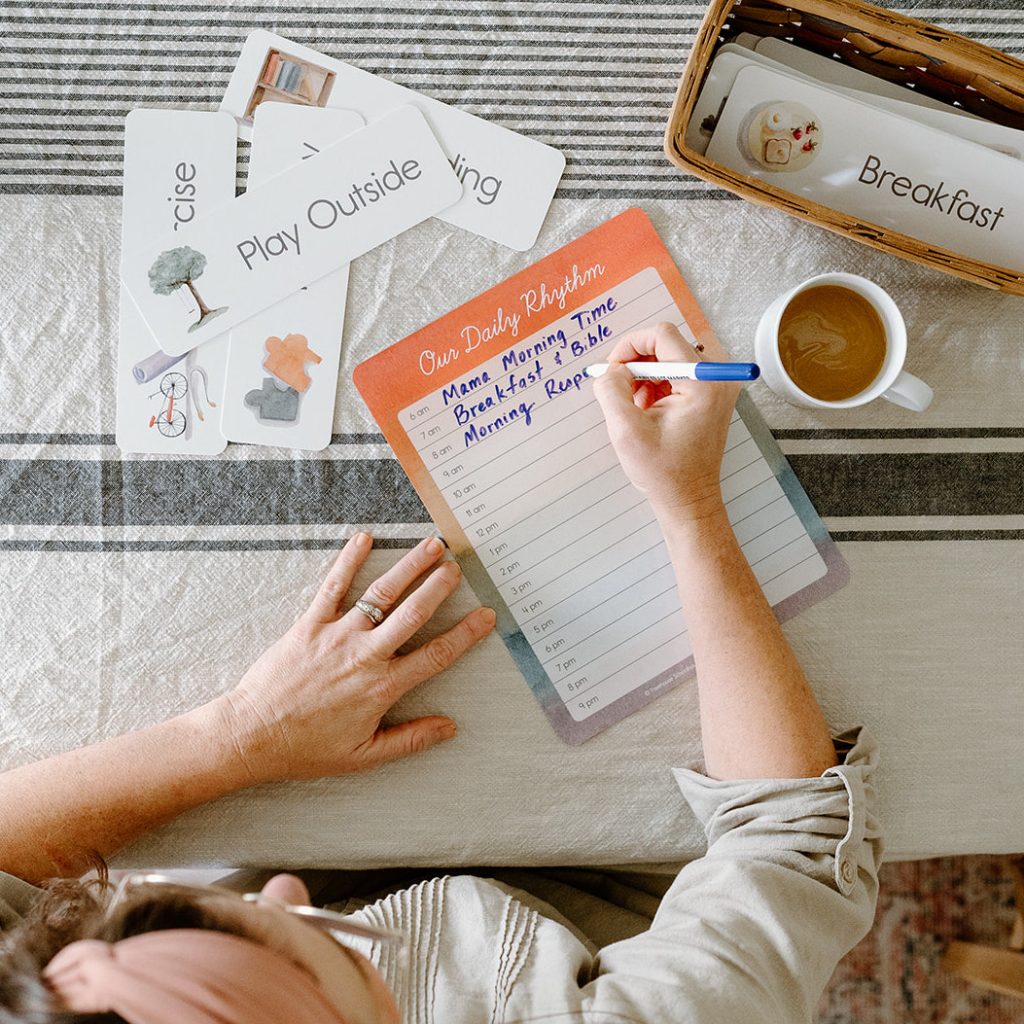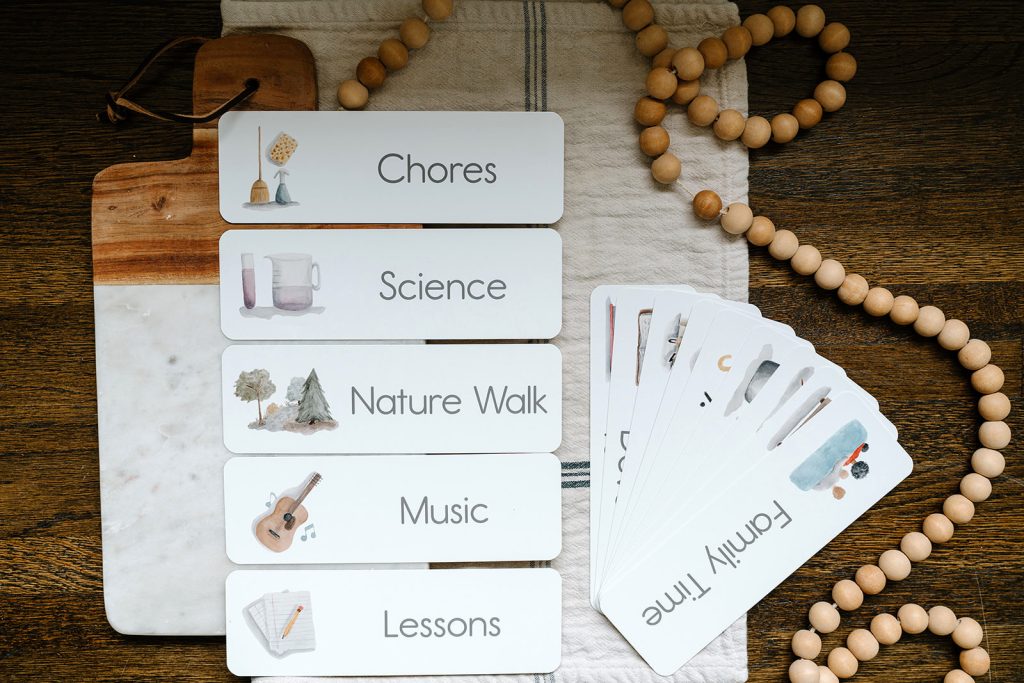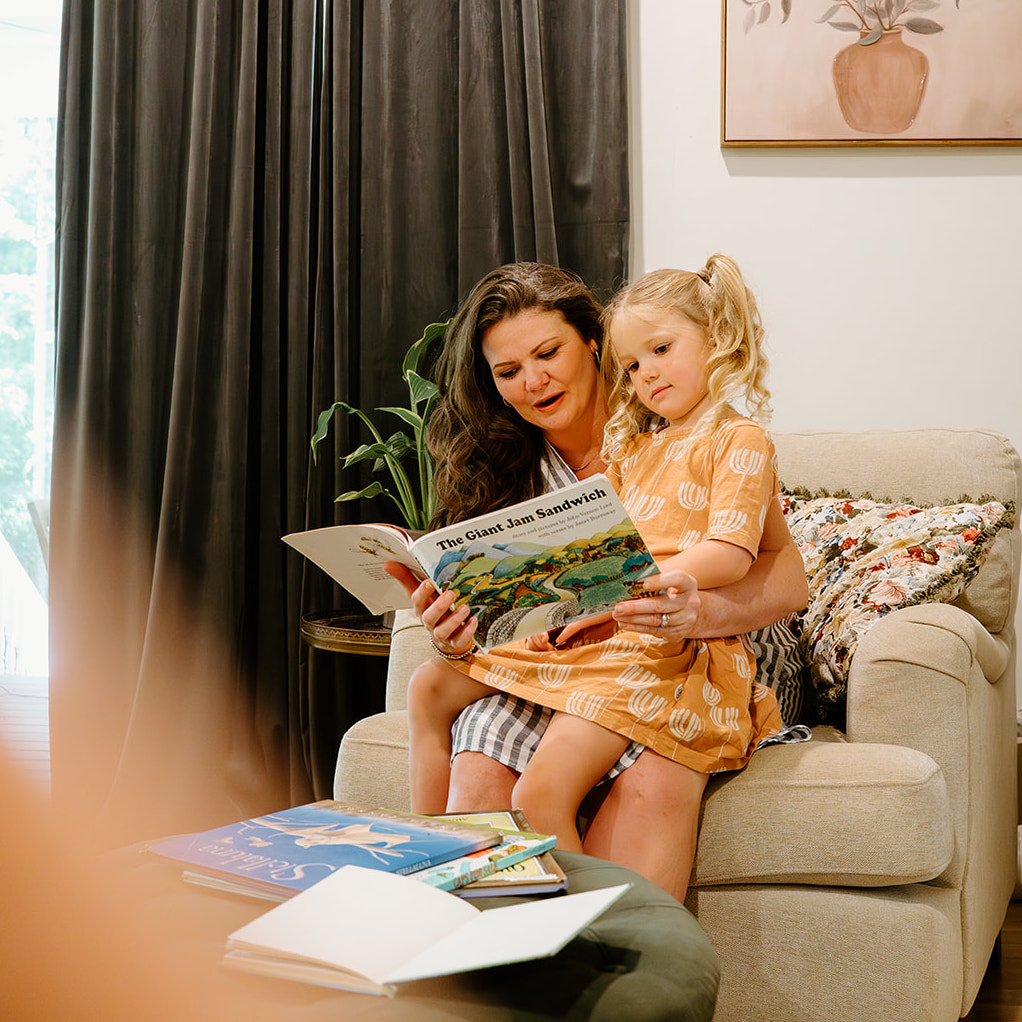This blog post was originally written in 2017 when my two oldest children were ages 3 and 4, before we were doing formal lessons. Our rhythms and routines have changed over the years as we have added children and our now “preschool-aged” children don’t follow this rhythm because we are also homeschooling older children.
Establishing a daily rhythm for preschool-aged children creates a sense of security and helps the days move along peacefully. A consistently ordered day allows for some structure, but also supports children’s emotional well-being and promotes a sense of independence. From wake-up time to getting dressed, eating breakfast, and each step of the day is an opportunity to create a loving environment in your home. In this blog post, I am sharing the daily rhythm I used for my children during the preschool years, before they entered formal lessons. I also share how to create a rhythm for your family.
In this blog post:
- Our family homeschool preschool daily rhythm
- How to create a family rhythm
- Favorite preschool resources from Treehouse Schoolhouse
Our family homeschool preschool daily rhythm

Rather than trying to stick to a rigid schedule, creating a general rhythm for my family helps us feel more in control and at peace without feeling like a failure if things don’t happen at exact times. I do like to have general times in mind for our days, but I try to keep our days open with a lot of margin so that when things don’t go as planned, there is room to shift things around.
We rely heavily on a visual schedule using the Daily Rhythm Cards from the Daily Rhythm Bundle. It is helpful for me to see during the day to recall what we have going on, plus for my children to know what to expect. I put put the cards in order for each day and move them around when things shift and change. I do this by using an adhesive-backed velcro strip on my wall and then cutting pieces of the soft side of the velcro on the back of each card.
I am passionate about giving children structure, as well as room to explore and play with no strings attached. We say “no” a lot and have zero regrets about that. Fridays are reserved for Auditory Verbal Therapy and time at my mom’s house or a field trip that relates to what we are learning. We guard our dinner times and weekend mornings for family togetherness. Sundays are reserved for worship and extended family meals and playtime with cousins. I am equally passionate about giving myself rest by creating margins in our routine for nature, reading, and sipping coffee.
Here is our entire schedule – not just the school part because I want you to see it in light of the big picture, in hopes of helping you discover what works best for your family. At the bottom of this post, I give you ten tips for creating your own family rhythm!
Here is a look into our weekday rhythm:
- 7:00 – 8:30 a.m. Morning routine
- 8:30 – 9 a.m Morning chores
- 9 – 9:45 a.m. Together time
- 9:45 – 11 a.m. Preschool activities
- 11 a.m. – 1 p.m. Outing and outdoor play
- 1 – 3:30 p.m. Lunch and rest time
- 3 – 5:30 p.m. free play
- 5:30 – 7:30 p.m. Dinner and nighttime routine
- 7:30 p.m. Children’s bed time
Here are the details of each section of our day.
Morning routine
My husband and I are awake an hour or two before the children wake up. We spend that time reading, journaling, praying, preparing for the day, working out, or just sitting and sipping coffee. At 7 a.m. I begin to make breakfast as the children come out of their rooms. They look at books, color, play in our sensory space, or work with the trays on our tray shelf. These trays have simple hands-on activities like puzzles and fine motor skills. We get dressed, eat breakfast together, and send my husband off to work. I clean up breakfast and set up for our school time while the children go back to their playing until I call us together for Together Time.
To take a look at what our together time looks like now with family style learning across all ages, read about Our Homeschool Morning Time.
Morning chores
On our big chalkboard in the main area of the house, I write a short list of chores for the morning that we will all do together. “Get Dressed” is the only one that is always there. I add in different ones each day according to what needs to be done or a skill I want them to learn. Some examples are wash windows, feed the pet fish, and sort laundry. All of these chores are done together at this point. We check off each chore and celebrate as they are accomplished.
Together time
This is my favorite part of our day. Titus and Josie grab their floor mats from our homeschool shelf and unroll them onto the living room rug to sit on. This gives them a reminder of personal space boundaries and keeps them from getting in front of each other while I am reading a story or leading them in a song. We start with prayer, inviting God to come into our day and open our minds to learn and understand. We thank Him for anything that comes to mind and pray for any needs going on around us. The children usually take turns praying aloud after I do. It’s often a jumbled mix of sweet words repeating some line I prayed, but it is a priority and habit I want to instill in them.
Then we sing a few songs that correlate with our theme. Usually our songs include hand and body motions, visuals, and/or instruments and rhythm sticks. If I have a felt board activity or story, I will do it then and let them take turns retelling it after me. At this point we often move to the cozy reading chair, and we read our books for the day. If they want to continue reading other books that are not part of the weekly theme, we do that as well. We transition to our other activities by pulling out some of the trays for the week and working with them on the living room floor. We wrap this time up based on their interest and involvement.
Preschool activities

Sometimes one of the children is still engaged with books, tray work, and the other is ready for something else. I follow their lead and invite them to the next planned activities when they are ready. Sometimes that means I am bouncing back and forth between them. These activities include arts and crafts, sensory play, letter recognition and formation, and basic math skills. We typically do these activities at the kitchen table, but sometimes they require movement, cooking, or adventuring which causes us to take our lesson elsewhere. I do not force any activity on them, but I encourage them to try each thing at least one time. My son is often resistant to anything he has never tried before, so having learning invitations available to him all throughout the day and following his lead is the key to success.
If you’re looking for quality, living books to read with your preschool-aged children, consider this free book list: 100 Living Books for the Early Years.
Outing and outdoor play

The children typically have their snack outside on the patio and listen to some audiobooks while I clean up from schooling. From then until rest time, I try to schedule things ahead of time that foster relationship and exploration. Sometimes that means we all go outside and make mud pies. Other days we walk a trail or have a picnic. Often we have playdates with friends, at our home or meet up at a park. One day a week my sister-in-law and niece come over and we all bake a treat together that correlates with what we are learning. Another day each week we go to the library to get the next unit’s books and attend preschool storytime.
Lunch and rest time
We often pack a picnic lunch for our morning adventure or eat outside if it is a nice day. Around 1 p.m. both of my children go into their rooms for rest time. They don’t always sleep, but they play quietly in their rooms until around 3 p.m. They usually ask to take books in their room or for me to get down some blocks or puzzles from their closets. During this time, I do household chores, lesson planning, and dinner prep.
Free play
This time is typically spent outside in our backyard. We have a trampoline, slide, swings, and a playhouse. Usually I find them playing with sticks, mud, and rocks. Sometimes they want to stay inside and continue exploring something we did that morning in school time, so sometimes afternoons are filled with more painting or sensory play. We have basic arts and crafts supplies out for them to use anytime they would like. They often ask for me to read to them again or sing some of the songs from the morning. Around 5 p.m. I typically allow them to watch a show while I prepare dinner.
Dinner and evening routine
After dinner, my husband usually bathes the children while I clean up and then we play or read books together in the living room until their bedtime around 7 or 7:30 p.m., depending on how worn out they are or if they napped or not.
Our days are both full and calm. It took a lot of trial and error to get to this place, and my hope for you is that you can glean from this to create the rhythm that suits your family’s unique needs and desires.
How to create a family rhythm

- Keep the whole family in mind – Don’t forget to keep in mind baby’s fussy hour and what your toddler needs as well.
- Focus on the order of events, not so much the times – It’s fine to write down times, but focus more on the order and rhythm of events than the actual times.
- Use a loop schedule – Don’t try to do every subject or every house chore every single day, loop some!
- Include home care and meal prep – Think about what it takes to keep your home running and plan it in!
- Implement a quiet time – All ages (including mom) benefit from a set rest time every afternoon.
- Have a visual schedule – Having the rhythm on cards for everyone to see the order for each day helps with staying on track. Make sure they’re easy to move around.
- Include personal care for Mama – Don’t forget you need time in your day to eat, get dressed, and maybe even read a book or exercise!
- Be honest with yourself – Don’t fall into the trap of creating a daily rhythm that is ideal, but is unrealistic.
- Leave margins in your day for play, rest, and the extra things that come up – Be generous in your time blocks to throw in the extras that inevitably happen.
- Hold it all with open hands – As needs change or you simply have an “off day,” be ready to throw the whole thing out and start from scratch.
Favorite preschool resources from Treehouse Schoolhouse
Are you looking for learning resources for your little ones? Consider these best-selling products from Treehouse Schoolhouse that offer a gentle invitation to learning.
Treehouse Story School: Preschool

Treehouse Story School: Preschool is 32-weeks of gentle, literature-based curriculum designed for ages 2.5-5 years. This preschool curriculum that invites children to learn through the themes in stories they love. Each week will focus on a picture book, inviting children into connection and learning through music and movement, play-based narration, alphabet and number play, motor skills, practical life development, crafts, and baking together.
It would be a great fit for your toddler or preschooler if you are looking to incorporate multi-sensory, play-based learning while introducing them to timeless stories.
From toddler through upper preschool, this curriculum can be used year after year as you dive deeper into beloved, classic stories your family will cherish. Preview a free week here.
Daily Rhythm Bundle

Children are highly visual–they can feel particularly out of control when they don’t know what to expect of their day. That’s why we recommend using a visual schedule to support your children from the time they are very young.
Rather than trying to stick to a rigid schedule, this set helps you create a general rhythm for your days. The daily rhythm worksheet is laminated and dry erase and the cards can be moved around offering you flexibility and adaptability.
Morning Time Bundle

This interactive, reusable set focuses on weather, seasons, moon phase, temperature, weather-appropriate clothing, date and time, and reading a calendar. With this daily bundle, your child will practice the skills of handwriting, tracing, copywork, and telling time. I recommend you print these materials and place them inside of a Morning Time Menu or dry-erase sleeve. Using dry-erase markers, your child can fill this bundle out over and over again.
We also offer a version of the Morning Time Bundle for those in our community who live in the Southern Hemisphere.
What do you include in your homeschool preschool daily rhythm? Let us know in the comments below.



